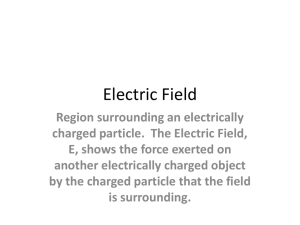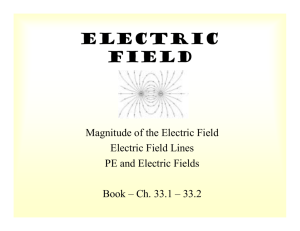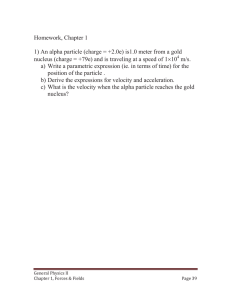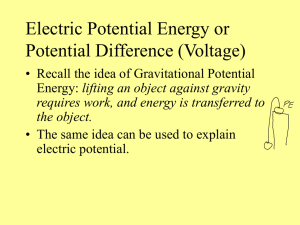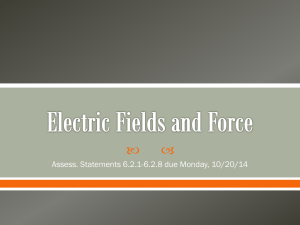Static electricity review
advertisement
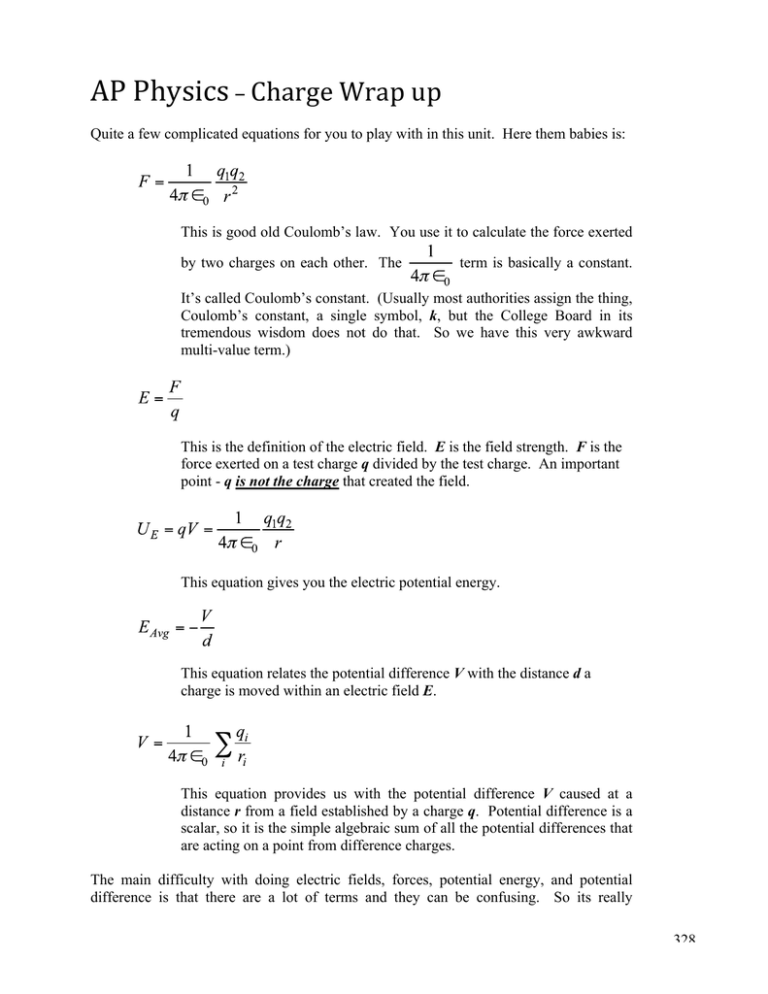
AP Physics – Charge Wrap up Quite a few complicated equations for you to play with in this unit. Here them babies is: This is good old Coulomb’s law. You use it to calculate the force exerted by two charges on each other. The term is basically a constant. It’s called Coulomb’s constant. (Usually most authorities assign the thing, Coulomb’s constant, a single symbol, k, but the College Board in its tremendous wisdom does not do that. So we have this very awkward multi-value term.) This is the definition of the electric field. E is the field strength. F is the force exerted on a test charge q divided by the test charge. An important point - q is not the charge that created the field. This equation gives you the electric potential energy. This equation relates the potential difference V with the distance d a charge is moved within an electric field E. This equation provides us with the potential difference V caused at a distance r from a field established by a charge q. Potential difference is a scalar, so it is the simple algebraic sum of all the potential differences that are acting on a point from difference charges. The main difficulty with doing electric fields, forces, potential energy, and potential difference is that there are a lot of terms and they can be confusing. So its really 328 important to know all this stuff cold. Somebody says, “Potential energy in a field.” And you are immediately thinking . Next, as has been our custom, are the things that the ever-wise College Board folks who produce the AP curriculum require you, the proud student, to do. A. Electrostatics 1. Charge, Field, and Potential a. You should understand the concept of electric field so you can: (1) Define it in terms of the force on a test charge. This is just an application of . (2) Calculate the magnitude and direction of the force on a positive or negative charge placed in a specified field. Similar to the one above. The force is found using . The direction is figured out logically using the old like charges repel unlike charges attract deal. (3) Given a diagram on which an electric field is represented by flux lines, determine the direction of the field at a given point, identify locations where the field is strong and where it is weak, and identify where positive or negative charges must be present. Simple stuff. Basically pie. The direction of the force is the direction of the force on a positive test charge and is tangent to the line of force. The arrows point in the direction of the force for a positive charge. The field is strong where the lines of force are close together. The force is weak where the lines of force are far apart. The lines of force come out of a charged body. If the lines are pointing away, the body is positive if the lines of force are pointing towards the body it’s negative. (4) Analyze the motion of a particle of specified charge and mass in a uniform electric field. Same kind of stuff as the one above, except we throw in Newton’s laws. So you find the force using Coulomb’s law, then figure out the acceleration using the second law (F = ma), and then the velocity. You can also use conservation of energy. You can also use energy. The potential energy of the field is going to be equal to the kinetic energy of the particle. We did several such problems. b. You should understand the concept of electric potential so you can: (1) Calculate the electrical work done on a positive or negative charge that moves through a specified potential difference. 329 The idea here is that the work done when moving a charge is equal to the change in its potential energy. You use the equations for potential energy. (2) Given a sketch of equipotentials for a charge configuration, determine the direction and approximate magnitude of the electric field at various positions. This would be a set of curves around a charge. Any point on the curve has the same potential difference as any other point on the curve. Pretty simple stuff. Use the lines of force to figure out the direction. (3) Apply conservation of energy to determine the speed of a charged particle that has been accelerated through a specified potential difference. Find the potential energy, assume it is all turned into kinetic energy and then solve for the velocity. . We did several of these problems. (4) Calculate the potential difference between two points in a uniform electric field, and state which is at the higher potential. Use the equation for electric field strength, potential difference, and distance . Calculate the potential for each point. Then recall that potential difference is a scalar, so you just add them algebraically to find their difference. 2. Coulomb’s Law and Field and Potential of Point Charges a. You should understand Coulomb’s Law and the principle of superposition so you can: (1) Determine the force that acts between specified point charges, and describe the electric field of a single point charge. You use Coulomb’s law to find the force. The electric field around a single point charge is simple – arrows point out for a positive charge and inward for a negative charge. (2) Use vector addition to determine the electric field produced by two or more point charges. This is where you add up the fields between the charges. This is a vector addition deal, so you have to resolve the vectors into x and y components. Remember the joy of that? b. You should know the potential function for a point charge so you can: (1) Determine the electric potential in the vicinity of one or more point charges. 330 This is where you use the equation for the potential difference in a field, good old . Anyway, pretty simple stuff. The potential difference is a scalar, so you just add ‘em up. 3. Fields and Potentials of Other Charge Distributions a. You should know the fields of highly symmetric charge distributions so you can: (1) Describe the electric field of: (a) Parallel charged plates. Basically the field looks like this: To describe the field, the Physics Kahuna would say that the lines of force are perpendicular to the surface of the plate and are all parallel and evenly spaced. Therefore the field is uniform (except at the ends). The arrows should point from positive to negative. B. Conductors 1. Electrostatics with Conductors a. You should understand the nature of electric fields in and around conductors so you can: (1) Explain the mechanics responsible for the absence of electric field inside a conductor, and why all excess charge must reside on the surface of the conductor. The Physics Kahuna did a lovely job of explaining all this in the handout. See the section on electric fields. (2) Explain why a conductor must be an equipotential, and apply this principle in analyzing what happens when conductors are joined by wires. All points in a conductor have the same potential difference. This is because the charge is free to move about – there is nothing to stop their moving about as much as they like. Join wires together and they will still have the same potential difference. (3) Determine the direction of the force on a charged particle brought near an uncharged or grounded conductor. This simply has to do with the old basic law of static electricity like charges repel and unlike charges attract. A positively charged particle will be attracted to the grounded conductor, which it will polarize. The same thing will happen to a negatively charged particle. It too will polarize the conductor. 331 Pretty much the same thing will happen to the uncharged conductor. b. You should be able to describe and sketch a graph of the electric field and potential inside and outside a charged conducting sphere. The electric field surrounding a charged conducting sphere (positive charge let’s say) would look like this: A negative charge on the sphere would be the same except that the arrows would be towards the sphere. The electric field and potential within the sphere would be zero – no field, no lines of force. c. You should understand induced charge and electrostatic shielding so you can: (1) Describe qualitatively the process of charging by induction. You have to admit that the old Physics Kahuna did a bang up job of explaining all this to his beloved students. See the handout. (2) Determine the direction of the force on a charged particle brought near an uncharged or grounded conductor. Didn’t we do this one already? Good thing that you don’t have to do much isn’t it? 332 Nasty Old AP Test Questions: From 2001: • Four charged particles are held fixed at the corners of a square of side s. All the charges have the same magnitude Q, but two are positive and two are negative. In Arrangement 1, shown to the right, charges of the same sign are at opposite corners. Express your answers to parts (a) and (b) in terms of the given quantities and fundamental constants. (a) For Arrangement 1, determine the following. i. The electrostatic potential at the center of the square. (This means potential difference.) Potential difference from one charge: Finding r: Potential difference at a point is the algebraic sum of all the potentials acting at that point; potential difference is a scalar: The potential difference is zero. The four values add up to zero. ii. The magnitude of the electric field at the center of the square. The electric field from each of the charges is a vector. The vectors appear as shown. You can see that the sum of these vectors is zero. Therefore, the electric field in the center of the square is zero. The bottom two charged particles are now switched to form Arrangement 2, shown to the right, in which the positively charged particles are on the left and the negatively charged particles are on the right. 333 (b) For Arrangement 2, determine the following. i. The electrostatic potential at the center of the square. Once again, the voltage in the center is zero. ii. Find the magnitude of the electric field at the at the center of the square. But So: To find E, we need the voltage: We already figured out the voltage in the first part of the problem, so we can plug that in. Remember that the distance was: EC will have same magnitude. 334 (c) In which of the two arrangements would more work be required to remove the particle at the upper right corner from its present position to a distance a long way away from the arrangement? ___Arrangement 1 ___Arrangement 2 Justify your answer. Arrangement 1 would require more work to move the upper right particle a great distance away. The Physics Kahuna’s reasoning? The removal of a negative particle is resisted because it’s close to a positive charge and it is helped because of its close distance to a negative charge. Arrangement 2 moves a positive charge farther away from the upper right particle and moves a negative charge closer to the upper right particle, both actions reducing the work needed to remove the upper right particle. Therefore, the arrangement 1 will require more work. From 1999: • In a television set, electrons are first accelerated from rest through a potential difference in an electron gun. They then pass through deflecting plates before striking the screen. a. Determine the potential difference through which the electrons must be accelerated in the electron gun in order to have a speed of 6.0 x 107 m/s when they enter the deflecting plates. The pair of horizontal plates shown below is used to deflect electrons up or down in the television set by placing a potential difference across them. The plates have length 0.040 m and separation 0.012 m, and the right edge of the plates is 0.50 m from the screen. A potential difference of 200. V is applied across the plates, and the electrons are deflected toward the top screen. Assume that the electrons enter horizontally midway between the plates with a speed of 6.0x107 m/s and that fringing at the edges of the plates and gravity are negligible. b. Which plate in the pair must be at the higher potential for the electrons to be deflected upward? Check the appropriate box below. Justify your answer. Upper plate Lower plate The electrons are attracted to the upper positive plate. The positive plate must be at the higher potential and the negative plate is ground. 335 c. Considering only an electron’s motion as it moves through the space between the plates, compute the following. i. The time required for the electron to move through the plates. ii. The vertical displacement of the electron while it is between the plates. d. e. Show why it is a reasonable assumption to neglect gravity in part (c). The force of electricity is billions and billions of times stronger. Gravity is negligible by comparison. Still neglecting gravity, describe the path of the electrons from the time they leave the plates until they strike the screen. State a reason for your answer. Moves in a straight line due to inertia. The electric field no longer acts on the particle. Gravity is too weak to cause a measurable deflection. From 1998: • A wall has a negative charge distribution producing a uniform horizontal electric field. A small plastic ball of mass 0.010 kg, carrying a charge of –80.0 µC, is suspended by an uncharged, nonconducting thread 0.30 m long. The thread is attached to the wall and the ball hangs in equilibrium, as shown below, in the electric and gravitational fields. The electric force on the ball has a magnitude of 0.032 N. a. On the diagram below, draw and label the forces acting on the ball. See above right 336 b. Calculate the magnitude of the electric field at the ball’s location due to the charged wall, and state its direction relative to the coordinate axis shown. The negative x direction. The electric field direction is the direction a positive test charge would go. Since the negative charge moves right, the field must be to the left. c. Determine the perpendicular distance from the wall to the center of the ball. The angle θ made by the tension force with the vertical is the same as the angle θ formed by the string with the vertical. This is shown in the drawing. We can solve for θ using trig. Once we know θ we can find r since we know l. d. The string is now cut. i. Calculate the magnitude of the resulting acceleration of the ball, and state its direction relative to the coordinate axis shown. The tension disappears, but w and FE are still present. The net force will be the sum of these two forces. Since they are perpendicular, we can use the good old Pythagorean theorem to find the net force. We now use the second law to find the acceleration acting on the ball: 337 ii. Describe the resulting path of the ball. Straight to the right and down. If t is missing from the FBD two forces are still acting. So the net force is down and to the right From 1996: • Robert Millikan received a Nobel Prize for determining the charge on the electron. To do this, he set up a potential difference between two horizontal parallel metal plates. He then sprayed drops of oil between the plates and adjusted the potential difference until drops of a certain size remained suspended at rest between the plates, as shown to the right. Suppose that when the potential difference between the plates is adjusted until the electric field is 10,000 N/C downward, a certain drop with a mass of 3.27 x 10-16 kg remains suspended. a. What is the magnitude of the charge on this drop? b. The electric field is downward, but the electric force on the drop is upward. Explain why. The electric field is oriented in reference to a positive test charge. A positive charge would move downward. However, a negative charge would experience the opposite effect, or a force upward. The drop must be negatively charged. c. If the distance between the plates is 0.01 m, what is the potential difference between the plates? d. The oil in the drop slowly evaporates while the drop is being observed, but the charge on the drop remains the same. Indicate whether the drop remains at rest, moves upward, or moves downward. Explain briefly. 338 Originally the drop did not move since gravity and the electric force were in equilibrium. But, if the drop looses mass then the force of gravity gets smaller. Since the charge does not change the upward electric force, is greater than the downward force. This unbalanced force will cause the drop to accelerate upward. 339


